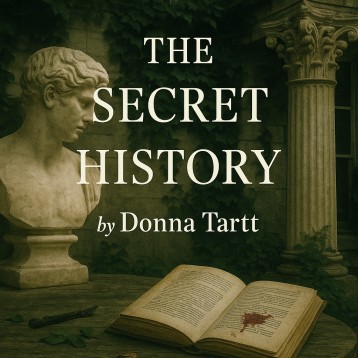The Secret History: Ambition's Dark Side
BOOKS REVIEW
Chaifry
9/30/20255 min read


Donna Tartt, the American novelist born in 1963 in Greenwood, Mississippi, has a knack for spinning stories that stick with you like a song you can’t shake off. Her first novel, The Secret History, published in 1992 by Alfred A. Knopf, made her a literary star at just 29, fresh out of Yale. With only three novels in three decades—The Little Friend (2002) and the Pulitzer-winning The Goldfinch (2013)—Tartt’s work is rare and rich, blending lush prose with deep questions about morality. The Secret History, a cult classic with over 2 million copies sold, is listed among Time’s 100 Best English-Language Novels from 1923 to 2005. It’s been called “a haunting philosophical thriller” by The New York Times (1992) and “a spellbinding debut” by The Guardian (1992). The book’s main idea is that chasing intellectual perfection and ancient ideals can lead to a dangerous spiral of pride
and tragedy, showing how thin the line is between ambition and ruin. It’s a wake-up call to the ground reality that the pursuit of “greatness” can hide darker urges, making it a must-read for its gripping mix of suspense and soul-searching. For Indian youngsters, it’s like a friend over chai, cautioning how the race for top marks or status can trap you in a web of your own making. This novel pulls you in to question what happens when you play god with your choices, a timeless story for a world rushing to keep up with ambition.
The Secret History is told through Richard Papen, a young man from California who lands at Hampden College in Vermont and falls in with an elite group of classics students. The story argues that their obsession with beauty and transcendence leads to murder, using Richard’s reflective voice to lay out the consequences. “It all started with a murder, or so I believed” (Tartt, 1992, p. 1). Richard joins Henry Winter, Bunny Corcoran, Francis Abernathy, and twins Charles and Camilla Macaulay, guided by their charismatic professor, Julian Morrow: “Julian was our mentor, and classics our sacred code” (p. 15).
The group dives into ancient rituals: “We read poetry under starlight, drunk on wine and ideas” (p. 30). Bunny’s loose talk stirs trouble: “Bunny’s chatter was a crack in our perfect world” (p. 45). “Julian taught us beauty is terror, and we bought it” (p. 60). A bacchanal goes horribly wrong: “The forest hid our madness, but blood marked the ground” (p. 75). “We crossed a line that night, and there was no return” (p. 90).
The group scrambles to cover up: “Bunny’s eyes accused us, and we couldn’t face them” (p. 105). “Our secret held us together, but it tore us apart” (p. 120). Henry takes charge: “He saw our act as a higher calling” (p. 135). “For a moment, we felt like gods, then just broken kids” (p. 150). Bunny’s death hits hard: “His body was a cruel reminder of our folly” (p. 165).
Guilt eats at them: “The classics we loved now haunted our sleep” (p. 180). “Richard’s story is a confession, heavy with regret” (p. 195). Camilla’s role deepens the pain: “She was our light, but also our shadow” (p. 210). The group fractures: “We drifted apart, ghosts of our past selves” (p. 225). “Our secret history owned us, and we paid the price” (p. 240). “The truth was a weight we couldn’t shake” (p. 255). “We wanted eternity, but got only ashes” (p. 270). Tartt uses Richard’s voice to unravel the cost of their arrogance.
The Secret History is a gem for its rich prose and deep dive into the human psyche, blending suspense with big questions about right and wrong. Tartt’s writing grabs you from the start: “It all started with a murder, or so I believed” (p. 1) sets a chilling tone. The book’s strength is its take on pride: “Julian taught us beauty is terror, and we bought it” (p. 60) captures the group’s dangerous obsession, as The New York Times (1992) calls it “a seductive moral puzzle.” The bacchanal scene, “The forest hid our madness, but blood marked the ground” (p. 75), is raw and gripping.
The characters leap off the page: “Bunny’s chatter was a crack in our perfect world” (p. 45) nails his careless charm. The paranoia of the cover-up, “Our secret held us together, but it tore us apart” (p. 120), builds a tense atmosphere. The warmth in Richard’s longing, “She was our light, but also our shadow” (p. 210), feels painfully real. The book’s appeal crosses borders, tapping into the universal pull of ambition gone wrong.
But it’s not flawless. The middle drags a bit: “For a moment, we felt like gods, then just broken kids” (p. 150) lingers on reflection, as The Guardian (1992) notes its “slow burn.” The book skips deeper social angles; the group’s elite bubble, “The classics we loved now haunted our sleep” (p. 180), ignores class or caste issues vital in India. The ending, “We drifted apart, ghosts of our past selves” (p. 225), feels a tad rushed. Compared to The Talented Mr. Ripley by Patricia Highsmith (1955), it’s more thoughtful but less fast-paced.
Still, The Secret History is a stunning debut, perfect for those who love literary thrillers. It’s not for readers wanting quick action but shines with its atmosphere and depth, a story that lingers like a late-night chat.
Why Indian Youth Readers Must Read This Book
For Indian youngsters caught in the grind of board exams, JEE coaching, and family expectations, The Secret History is like a friend over chai, warning how chasing “the best” can lead you down a dark path. The pressure to score 99% feels like the group’s obsession with perfection: “Julian taught us beauty is terror, and we bought it” (p. 60). Rote learning, where marks define you, is like their blind devotion: “We crossed a line that night, and there was no return” (p. 90). This book’s a wake-up call to question what you’re running after.
The job market, with lakhs fighting for a few seats, mirrors the group’s isolation: “Our secret held us together, but it tore us apart” (p. 120). For kids from small towns or lower castes, “Bunny’s chatter was a crack in our perfect world” (p. 45) feels like being the odd one out in a shiny world. The book’s lesson on pride, “For a moment, we felt like gods, then just broken kids” (p. 150), pushes for staying grounded.
For girls, facing “settle down soon” talks, “She was our light, but also our shadow” (p. 210) captures the weight of being everyone’s ideal. The ground reality is that rote systems prize results over self, leaving youngsters playing catch-up with who they really are. “Our secret history owned us, and we paid the price” (p. 240) says take charge of your story, not someone else’s.
The book’s reflection, “Richard’s story is a confession, heavy with regret” (p. 195), is like journaling after a tough day. “The truth was a weight we couldn’t shake” (p. 255) reminds you to face reality. “We wanted eternity, but got only ashes” (p. 270) warns against chasing empty goals, like marks over meaning. “We read poetry under starlight, drunk on wine and ideas” (p. 30) feels like late-night talks with friends, dreaming big but staying real. The Secret History teaches Indian youngsters to chase dreams with care, a guide for thriving in a world full of expectations.
The Secret History is a gripping, thought-provoking novel about the dangers of unchecked ambition. For Indian youth, it’s a mirror to societal pressures, urging wisdom over pride. This book’s a call to live thoughtfully, perfect for those who love stories that challenge and linger like a deep conversation.
